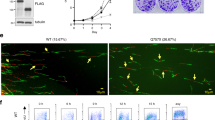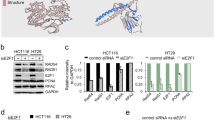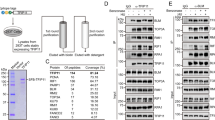Abstract
Bloom's syndrome (BS) is a rare human autosomal recessive disorder characterized by an increased risk to develop cancer of all types. BS cells are characterized by a generalized genetic instability including a high level of sister chromatid exchanges. BS arises through mutations in both alleles of the BLM gene which encodes a 3′–5′ DNA helicase identified as a member of the RecQ family. We developed polyclonal antibodies specific for the NH2- and COOH-terminal region of BLM. Using these antibodies, we analysed BLM expression during the cell cycle and showed that the BLM protein accumulates to high levels in S phase, persists in G2/M and sharply declines in G1, strongly suggestive of degradation during mitosis. The BLM protein is subject to post-translational modifications in mitosis, as revealed by slow migrating forms of BLM found in both demecolcine-treated cells and in mitotic cells isolated from non-treated asynchronous populations. Phosphatase treatment indicated that phosphorylation events were solely responsible for the appearance of the retarded moieties, a possible signal for subsequent degradation. Together, these results are consistent with a role of BLM in a replicative (S phase) and/or post-replicative (G2 phase) process.
This is a preview of subscription content, access via your institution
Access options
Subscribe to this journal
Receive 50 print issues and online access
$259.00 per year
only $5.18 per issue
Buy this article
- Purchase on Springer Link
- Instant access to full article PDF
Prices may be subject to local taxes which are calculated during checkout






Similar content being viewed by others
Abbreviations
- BS:
-
Bloom's syndrome
- DSB:
-
double-strand break
- SCE:
-
sister chromatid exchanges
References
Aberle H, Bauer A, Stappert J, Kispert A and Kemler R . 1997 EMBO J 16: 3797–3804
Bahr A, De Graeve F, Kedinger C and Chatton B . 1998 Oncogene 17: 2565–2571
Chakraverty RK and Hickson ID . 1999 BioEssays 21: 286–294
Chester N, Kuo F, Kozak C, O'Hara CD and Leder P . 1998 Genes Dev 12: 3382–3393
Clurman BE, Sheaff RJ, Thress K, Groudine M, and Roberts JM . 1996 Genes Dev 10: 1979–1990
Coux O, Tanaka and Kand Goldberg AL . 1996 Ann Rev Biochem 65: 801–847
Ellis NA, Groden J, Ye TZ, Straughen J, Lennon DJ, Ciocci S, Proytcheva M and German J . 1995 Cell 83: 655–666
Fenteany G, Srandaert RF, Lane WS, Choi S, Corey EJ and Schreiber SL . 1995 Science 268: 726–731
Frei C and Gasser SM . 2000 Genes Dev 14: 81–96
Gangloff S, McDonald JP, Bendixen C, Arthur L and Rothstein R . 1994 Mol Cell Biol 14: 8391–8398
German J . 1993 Medicine 72: 393–406
German J . 1997 Cancer Genet Cytogenet 93: 100–106
Gharibyan V and Youssoufian H . 1999 Mol Carcinog 26: 261–273
Gianneli F, Benson PF, Pawsey SA and Polani PE . 1977 Nature 265: 466–469
Hand R and German J . 1975 Proc Natl Acad Sci USA 72: 758–762
Jordan MA, Toso RJ, Thrower D and Wilson L . 1993 Proc Natl Acad Sci USA 90: 9552–9556
Karow JK, Chakraverty RK and Hickson ID . 1997 J Biol Chem 272: 30611–30614
Kitao S, Ohsugi I, Ichikawa K, Goto M, Furuichi Y and Shimamoto A . 1998 Genomics 54: 443–452
Kühne C and Banks L . 1998 J Biol Chem 273: 34302–34309
Kusano K, Berres ME and Engels WR . 1999 Genetic 151: 1027–1039
Lanker S, Valdivieso MH and Wittenberg C . 1996 Science 271: 1597–1601
Levenson V and Hamlin JL . 1993 Nucl Acids Res 21: 3997–4004
Lonn U, Lonn S, Nylen U, Winblad G and German J . 1990 Cancer Res 50: 3141–3145
McGarry J and Kirschner MW . 1998 Cell 93: 1043–1053
Muller H and Scott R . 1992 Mutat Res 284: 15–24
Murray JM, Lindsay HD, Munday CA and Carr AM . 1997 Mol Cell Biol 17: 6868–6875
Neff NF, Ellis NA, Zhang Ye T, Noonan J, Huang K, Sanz M and Proytcheva M . 1999 Mol Biol Cell 10: 665–676
Orford K, Crockett C, Jensen JP, Weissman AM and Byers SW . 1997 J Biol Chem 272: 24735–24738
Puranam KL and Blackshear PJ . 1994 J Biol Chem 269: 29838–29845
Rock KL, Gramm C, Rothstein L, Clark K, Stein R, Dick L, Hwang D and Goldberg AL . 1994 Cell 78: 761–771
Rodman TC, Flehinger BJ and Rohlf FJ . 1980 Cytogenet Cell Genet 27: 98–110
Seki M, Miyazawa H, Tada S, Yanagisawa J, Yamaoka T, Hoshino SI, Ozawa K, Eki T, Nogami M, Okumura K, Taguchi H, Hanaoka F and Enomoto T . 1994 Nucl Acids Res 22: 4566–4573
Skoog L and Nordenskjöld B . 1971 Eur J Biochem 19: 81–89
Sonoda E, Sasaki MS, Morrison C, Yamaguchi-Iwai Y, Takata M and Takeda S . 1999 Mol Cell Biol 19: 5166–5169
Stewart E, Chapman CR, Al-khodairy F, Carr AM and Enoch T . 1997 EMBO J 16: 2682–2692
Umezu K, Nakayama K and Nakayama H . 1990 Proc Natl Acad Sci USA 87: 5363–5367
Walpita D, Plug AW, Neff NF, German J and Ashley T . 1999 Proc Natl Acad Sci USA 96: 5622–5627
Wang TS . 1991 Annu Rev Biochem 60: 513–552
Watt PM, Louis EJ, Borts RH and Hickson ID . 1995 Cell 81: 253–260
Yu CE, Oshima J, Fu YH, Wijsman EM, Hisama F, Alish R, Matthews S, Nakura J, Miki T, Ouais S, Martin GM, Mulligan J and Schellenberg GD . 1996 Science 272: 258–262
Zhuo S, Clemens JC, Hakes DJ, Barford D and Dixon JE . 1993 J Biol Chem 268: 17754–17761
Acknowledgements
We thank Valérie Schiavon (IFR 54, IGR, Villejuif) and Yann Lécluse (IFR54, IGR, Villejuif) for expert assistance in sorting cells by flow cytometry and in FACS analysis and C Hauss (IGBMC, Illkirch) for technical assistance. We thank Marc Lipinski (CNRS UMR 1598, IGR, Villejuif) for invaluable stimulating discussions and critical reading of the manuscript. We also thank Anne Bahr and Claude Kedinger (IGBMC, Illkirch), Michel Bornens and Bruno Goud (CNRS UMR144, Institut Curie, Paris), Salem Chouaib (INSERM U487, IGFR, Villejuif) and Joëlle Wiels (CNRS UMR 1598, IGR, Villejuif) for their advice and helpful discussions. We are grateful to the anonymous referees for their advice concerning post-translational modifications of the mitotic BLM. This work was supported by funds and/or fellowships from the Centre National de la Recherche Scientifique, the Institut National de la Santé et de la Recherche Médicale, the Centre Hospitalier Universitaire Régional, the Association pour la Recherche sur le Cancer (ARC 9400 and 9660, to Mounira Amor-Guéret, ARC 9479 to Claude Kedinger), the Groupement des Entreprises Françaises dans la Lutte contre le Cancer, the Fondation de France, the Ligue Nationale contre le Cancer and the Université Louis Pasteur de Strasbourg. Stéphanie Dutertre is a recipient of a fellowship from the Ministère de l'Education Nationale, de la Recherche et de la Technologie and Mouna Ababou is a recipient of a fellowship from the Ligue Nationale contre le Cancer (Comité de la Haute-Savoie).
Author information
Authors and Affiliations
Rights and permissions
About this article
Cite this article
Dutertre, S., Ababou, M., Onclercq, R. et al. Cell cycle regulation of the endogenous wild type Bloom's syndrome DNA helicase. Oncogene 19, 2731–2738 (2000). https://doi.org/10.1038/sj.onc.1203595
Received:
Revised:
Accepted:
Published:
Issue Date:
DOI: https://doi.org/10.1038/sj.onc.1203595
Keywords
This article is cited by
-
Investigating the pathogenic SNPs in BLM helicase and their biological consequences by computational approach
Scientific Reports (2020)
-
hSSB1 associates with and promotes stability of the BLM helicase
BMC Molecular Biology (2017)
-
Mitotic phosphorylation of Bloom helicase at Thr182 is required for its proteasomal degradation and maintenance of chromosomal stability
Oncogene (2016)
-
On BLM helicase in recombination-mediated telomere maintenance
Molecular Biology Reports (2013)
-
RecQ helicases: guardian angels of the DNA replication fork
Chromosoma (2008)



